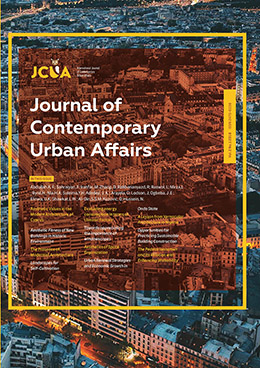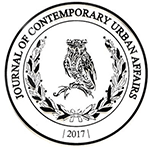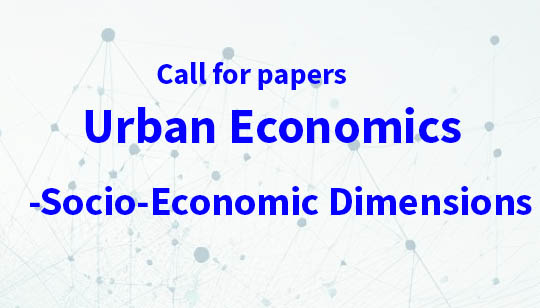The Presence of Modernist Architecture in Government’s educational Buildings at Lefkosa
DOI:
https://doi.org/10.25034/ijcua.2018.3653Keywords:
Modern architecture, Elements of modernist architecture, Modernism philosophy, Government’s educational buildings, LefkoşaAbstract
Modernist architecture movement of the buildings in any city reflects the modernity of that city. Lefkosa as a modern city faced many conflicts in the last century. The governmental buildings illustrate how modernism in architecture was defined and reflected in the buildings of the city. The aim of this paper is to explore the modernism movement in architecture influence on educational governmental buildings in Lefkosa for the first half in the 20th century. The paper focuses on the ideas and experiences of modernist architects in the first half of the 20th century to apply modernism elements and relationship between architecture form and functionalism in governmental buildings. Methodology framework elucidated to conduct the subject. Two School buildings have been selected from the first half of the twentieth century in Lefkosa as case studies for modernist architecture. ‘Lefkosa türk lisesi’ designed by ‘Ahmet Vural Bahaedden’, which was one of the famous modernist architects in Cyprus and ‘sehit Ertugrul Ilkokulu’. The buildings architectural elements analyzed in both schools to demonstrate the relationship between site, interior space, functionality and environmental response, based on using their modern material and character. The paper concluded that the educational buildings hold strong elements of the modernist architecture in Lefkosa and demonstrate how the elements of modernism were involved functionally in the design. The findings contribute useful evidence about the existence of modernism philosophy in architecture in Lefkosa in the first half of the twentieth century.
Downloads
References
Ali. A. F. (2018). The Influence of Le Corbusier On the emergence of the Aesthetic Values in the Modern Architecture of Cyprus. Contemporary Urban Affairs (JCUA), 2(1), 1-12. https://doi.org/10.25034/ijcua.2017.3650
Amen, A. M. (2017). Oeuvre vs. The inspiration of Bauhaus principles on the modern housing in Cyprus. Journal of Contemporary Urban Affairs (JCUA), 1(2), 21-32. https://doi.org/10.25034/ijcua.2017.3645
Robinson, J. F. (2003). Gro wth Efficiency and Modernis. USA: GSA. https://www.amazon.com/Growth-Efficiency-Modernism-Buildings-1950s/dp/B000SLHWHK
Zabihi, S. (2010). Evaluating the Effects of Modern Movement on Contemporary Residential Buildings in Iran’s Capital City- Tehran. Tehran: Iran. Available at: http://i-rep.emu.edu.tr:8080/xmlui/bitstream/handle/11129/131/Saereh.pdf?sequence=1
Evans, C., Jeffery R. B. (2005). Architecture of the modern movement in Tucson 1945-1975. Tucson, USA: MAPP. Available at: http://capla.arizona.edu/mapptucsonorg/context_study.pdf
Savio, A. M. (2006). The Spirit of the New. Project report, Roskilde University, Roskilde. Denmark: International Basic Studies in the Humanities. https://docplayer.net/54011579-Modernity-tradition-and-identity-in-the-developing-world.html
Salah Muhy Al-Din, S. (2017). The influence of Mediterranean modernist movement of architecture in Lefko?a: The first and early second half of 20th century. Journal of Contemporary Urban Affairs, 1(1), 10-23. Doi: 10.25034/1761.1(1)10-23. https://doi.org/10.25034/1761.1(1)10-23
Tungare, A. (2001). Le Corbusier's principles of city planning and thelr application in virtual environments . Master thesis, University of Carlenton,Ottawa. Ontario:Canada . https://www.collectionscanada.gc.ca/obj/s4/f2/dsk3/ftp04/MQ61319.pdf
Dalrymple, T. (2009). 'The Architect as Totalitarian: Le Corbusier’s baleful influence’. City Journal, Autumn, 19(4). https://patterns.architexturez.net/doc/az-cf-172911
Campbell, R. (n.d.). Campaigning for Twentieth century architecture. The Twentieth Century Society:Britain .Retrived from http://www.c20society.org.uk/100-buildings/impington-village-college-cambridgeshire/
Walter Gropius- master of Modern architecture. (2011). Retrieved from https://taylorsimons.wordpress.com/tag/impington-village-college/
Hille,T.(2011). Modern Schools: A Century of Design for Education. John Wiley & Sons. https://www.abebooks.com/book-search/title/modern-schools-century-design/author/hille/
Jones, G. (2011). What is modern: characteristics of modern architecture? Retrieved from http://a2modern.org/2011/04/characteristics-of-modern-architecture/
Baker, L. (2012). A History of School Design and its Indoor Environmental Standards, 1900 to Today. Washington, DC: National Clearinghouse for Educational Facilities. http://www.ncef.org/pubs/greenschoolshistory.pdf
Pyla, P. ,Phokaides,P. (2009). Architecture and Modernity in Cyprus. Cyprus: Twentieth-Century Cyprus. eahn newsletter,(2). https://www.academia.edu/4987823/Architecture_and_Modernity_in_Cyprus
Nicosia - North Cyprus capital city. (2007). Retrived from http://www.lefkosa.com/
The turkish republic of northern cyprus . (2014). Lefcosa: Bolan Dijital Bask? Ltd.
Celik, D. and Erturk, Z. (2007). Analysis of the Modernist Language in Cyprus: A Case Study on a local architect. 5th International postgraduate research conference in the built and human environment in conjunction with the 2nd International Built and Human Environment Research Week. Dept. of Interior Architecture, Eastern Mediterranean University, Famagusta, Cyprus. http://docplayer.net/59518068-Newsletter-research-september-no-3-eastern-mediterranean-university.html
A plan conceived in the mind. Impington Village College. (2011). Retrieved on (20th May2016) from https://taylorsimons.wordpress.com/tag/impington-village-college/
Published
How to Cite
Issue
Section
License
Copyright (c) 2018 Journal of Contemporary Urban Affairs

This work is licensed under a Creative Commons Attribution-NonCommercial-NoDerivatives 4.0 International License.

















